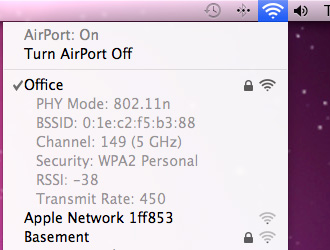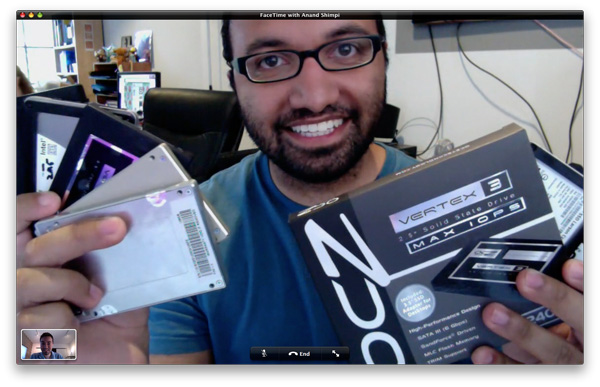The 27-inch Apple iMac Review (2011)
by Anand Lal Shimpi on May 27, 2011 2:30 AM ESTFaceTime HD
Like the new MacBook Pros, the new iMac ships with a 1280 x 720 video/still camera mounted in the top bezel of the display. The FaceTime experience is pretty similar to what we saw on the MacBook Pro. The 720p video is encoded in real time (using Quick Sync) and sent at up to 2Mbps to its recipient. Image quality is pretty good assuming you have a well lit room and that you have the upload bandwidth to spare:
Photo Booth ships with the system and continues to capture at 640 x 480 by default. It's clear that Apple needs to do a better job of aligning updates to its software with its hardware release schedule.
Network Performance
Like the new 2011 MacBook Pros, the new iMac has an 802.11n WiFi adapter that supports up to three spatial streams. While Broadcom is responsible for the MacBook Pro hardware, Atheros provides WiFi in the iMac (at least for the 21.5-inch model).
As Brian correctly pointed out in our MacBook Pro review, Apple's Time Capsule and Airport Extreme have supported three spatial streams for a while - they just haven't had any clients that could use all three.
Each stream is good for up to 150Mbps, which brings the max negotiated speed of the new iMac up to 450Mbps:

In practice you get far less than that of course:
| 802.11n Network Performance Comparison | ||||
| 27-inch iMac (Mid 2011) | 15-inch MacBook Pro (Early 2011) | |||
| Peak Network Transfer Speed | 150Mbps | 133Mbps | ||
Not as tuned for low power consumption the new iMac actually achieves higher throughput than the MacBook Pro connected to the same Apple Time Capsule.
Range is also improved compared to the MacBook Pro's 3x3 implementation. I saw more APs available on the iMac, which isn't too surprising:
iMac WiFi  |
MacBook Pro WiFi  |
The benefits of better range and higher throughput are less important on a desktop, unless you're one of those people who carries your iMac to coffee shops (in which case, yay?).











139 Comments
View All Comments
tipoo - Friday, May 27, 2011 - link
Nevermind me, it was answered in the article.tipoo - Friday, May 27, 2011 - link
I heard that unlike previous iMacs, the new ones can only use another mac with Thunderbolt to use the iMac as a targeted display. Is that true? I wouldn't feel so bad about discarding such a system when the GPU and CPU feel too old in two or three years like Anand mentioned if I could use it as an external display, but I think the new ones are limited to only being used by other Macs. And that's also assuming Mac's in 3 years will use compatible Thunderbolt ports.TegiriNenashi - Friday, May 27, 2011 - link
What is wrong with this display? Just one number: 16:9.QuietOC - Friday, May 27, 2011 - link
I have used a 20" white iMac and 24" aluminum iMac. The later has a big persistent image problem. Evidently IPS pixels don't work well in a hot environment. The low noise level of the iMac is nice to mostly not hear, but the visual noise might be worse.Also the cheap 320GB WD Caviar failed by randomly disappearing which may have be heat related, and the USB ports have also started randomly disconnecting. The mouse and keyboard just stop working during the day and I have to unplug them and plug them back in. So, no, I would not recommend getting a $1000 monitor with a computer mounted inside it.
KoolAidMan1 - Friday, May 27, 2011 - link
I've owned both the 24" iMac you talk about and a 27" from late 2009. Image persistence became a problem with the 24" models, as well as the CCFL losing some of its brightness by the two year mark.The new 27" models do not have either issue. Image persistence has been fixed, and I don't expect there to be any fading since LED backlights don't suffer from the same degredation issues that CCFL backlit displays do over time. On a related note, I have a NEC 2490WUXi as my secondary display. That monitor uses the same 24" H-IPS panel that the old 24" iMac did. It has minor image retention issues, but not to the same degree as the iMac had. Whatever LG did with their new 27" panels seems to have addressed that problem.
zhill - Friday, May 27, 2011 - link
First off, nice article Anand. Well presented and I think your perspective is a common one in this case. I agree that the lack of upgrade options and rather mediocre gpu performance are certainly off-putting for a machine in this price range, but I also think that your observation that if you are willing to spend $1800 for a laptop with a reasonably short lifecycle then the iMac is not much different. I think you've really hit the point there--the iMac's target customer.I would argue that most iMac users are not highly technical, power users. They are people that want a big screen and don't need the portability of a laptop. These people, like my parents, value the simplicity and ease of use of the iMac and the fact that their workspace is often small and would rather it not be covered in cords and cables. In that case not only does the iMac make sense but it's lifespan is substantially longer and all the GPU they need is enough to drive the system and maybe do some video editing. Gaming prowess has never been an apple concern and I doubt it will be until Steve Jobs decides to buy Activision or EA. I do like the iMac from a compute appliance perspective, just plug it in and compute--no fuss. Also, trying to make a reasonable gaming rig with a 2560x1440 display is a fairly daunting task even with today's cards. You would have to be near the top-end and that's a whole lot of power and heat to dissipate in a reasonably small enclosure (considering the size of a 6970 or 580 card by itself).
I also have to say that Intel's recent willingness to keep switching chip sockets has made upgrades far more painful than they should be (yes, I have a core i7-920 with socket 1366 that is now essentially orphaned).
Alberts - Friday, May 27, 2011 - link
Securedoc for Mac from a company called Winmagic supports SSD's with encryption hardware as long they adhire to the opal specification from the trusted computing groupJimmiG - Friday, May 27, 2011 - link
You can't upgrade the hardware and you can't separate the computer from the display so you can keep using the display long after the hardware has become obsolete.That's pretty much the oposite of "green".
Spazweasel - Friday, May 27, 2011 - link
This may be old news (I'm not going to wade through 6 pages of Apple-hating trolls to see), but you CAN use your 27" iMac as a monitor:http://support.apple.com/kb/HT3924
It's called "Target Display Mode".
KoolAidMan1 - Friday, May 27, 2011 - link
Note that it is only talking about the 2009 and 2010 models with mini-DP ports. Those can take an external source so you can use the 27" iMac as a monitor. I use it every day as the primary monitor for my gaming PC.The new 2011 iMacs have different requirements since they switched to Thunderbolt ports. Until an adapter or something comes out, the only sources that can output a video signal to the 2011 iMacs are Thunderbolt equipped computers. For the time being this only limits them to 2011 Macbook Pros and other iMacs (which would be a weird application).
I love the iMacs, but as someone who uses Target Display Mode every day, the new requirements bother me. It won't be a problem in a year or so when Thunderbolt becomes more common, but for the time being it is pretty limiting.